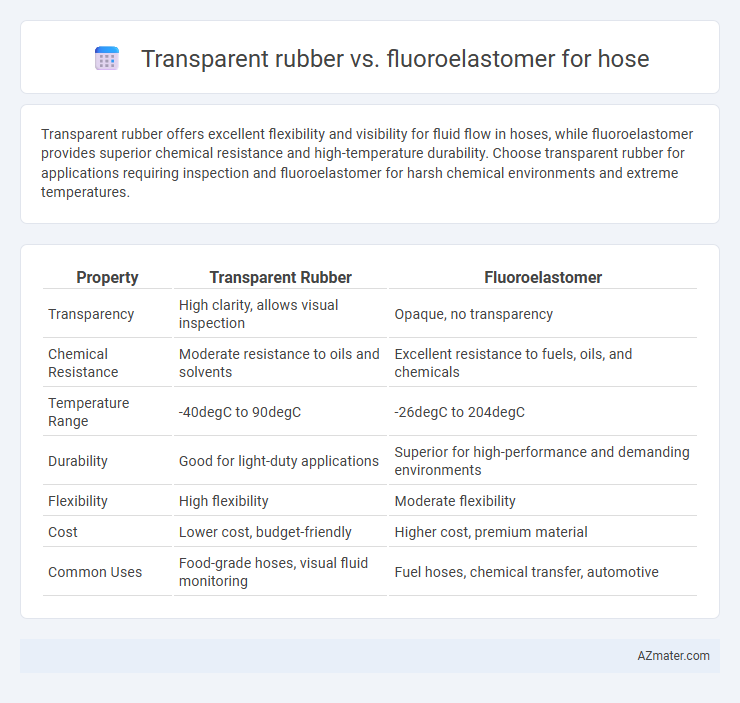Transparent rubber offers excellent flexibility and visibility for fluid flow in hoses, while fluoroelastomer provides superior chemical resistance and high-temperature durability. Choose transparent rubber for applications requiring inspection and fluoroelastomer for harsh chemical environments and extreme temperatures.
Table of Comparison
| Property | Transparent Rubber | Fluoroelastomer |
|---|---|---|
| Transparency | High clarity, allows visual inspection | Opaque, no transparency |
| Chemical Resistance | Moderate resistance to oils and solvents | Excellent resistance to fuels, oils, and chemicals |
| Temperature Range | -40degC to 90degC | -26degC to 204degC |
| Durability | Good for light-duty applications | Superior for high-performance and demanding environments |
| Flexibility | High flexibility | Moderate flexibility |
| Cost | Lower cost, budget-friendly | Higher cost, premium material |
| Common Uses | Food-grade hoses, visual fluid monitoring | Fuel hoses, chemical transfer, automotive |
Introduction to Transparent Rubber and Fluoroelastomer Hoses
Transparent rubber hoses offer excellent visibility of fluid flow, combining flexibility with chemical resistance suitable for low to moderate temperature applications. Fluoroelastomer hoses provide superior chemical, heat, and oil resistance, making them ideal for high-performance environments requiring durability and long-term reliability. Selection between these materials depends on specific operational conditions, including temperature range, chemical exposure, and visibility requirements.
Material Composition and Manufacturing Process
Transparent rubber hoses are typically made from silicone or polyurethane, offering excellent flexibility and visibility for fluid flow, while fluoroelastomer hoses are composed of fluorocarbon polymers like Viton, known for superior chemical resistance and high-temperature stability. The manufacturing process for transparent rubber hoses involves extrusion and curing to maintain clarity and elasticity, whereas fluoroelastomer hoses undergo specialized molding and vulcanization to enhance durability and resistance to harsh environments. These differences in material composition and processing significantly affect the hose's application range, with transparent rubber suited for visible, low chemical exposure uses and fluoroelastomer preferred in aggressive chemical and high-temperature conditions.
Key Physical and Chemical Properties Comparison
Transparent rubber hoses exhibit excellent flexibility and clarity with moderate chemical resistance, making them ideal for visual fluid monitoring and light chemical exposure. Fluoroelastomer hoses offer superior resistance to high temperatures, aggressive chemicals, and oils, maintaining durability under extreme conditions but lack transparency. The key distinction lies in fluoroelastomer's exceptional chemical inertness and thermal stability compared to the more versatile but less resistant transparent rubber compounds.
Durability and Longevity in Hose Applications
Transparent rubber hoses offer moderate durability with good flexibility but tend to degrade faster under exposure to UV light and chemicals compared to fluoroelastomer hoses. Fluoroelastomers provide superior longevity due to their exceptional resistance to heat, chemicals, and ozone, making them ideal for demanding industrial hose applications. Their enhanced durability reduces maintenance frequency and extends service life, ensuring reliable performance in harsh environments.
Transparency: Visibility and Monitoring Advantages
Transparent rubber offers superior visibility in hoses, enabling real-time monitoring of fluid flow and contamination detection without equipment disassembly. Fluoroelastomer, while highly resistant to chemicals and temperature extremes, lacks transparency, limiting visual inspection capabilities. Choosing transparent rubber enhances operational safety and maintenance efficiency by allowing quick identification of blockages or leaks.
Chemical Resistance and Environmental Suitability
Transparent rubber offers moderate chemical resistance, suitable for applications involving mild acids, bases, and alcohols, but degrades quickly when exposed to oils, fuels, and harsh solvents. Fluoroelastomer excels in chemical resistance, withstanding aggressive chemicals, fuels, oils, and high temperatures, making it ideal for extreme industrial environments. Environmental suitability favors fluoroelastomer due to its outstanding durability, UV resistance, and minimal permeability, while transparent rubber is limited in outdoor and harsh chemical exposure scenarios.
Flexibility, Handling, and Installation Differences
Transparent rubber hoses offer superior flexibility and ease of handling due to their pliable material, allowing for smooth bending and simplified installation in tight spaces. Fluoroelastomer hoses provide excellent chemical resistance and durability but tend to be stiffer, resulting in more challenging manipulation and installation. The choice between transparent rubber and fluoroelastomer hose materials significantly impacts operational efficiency, especially in applications requiring frequent movement or complex routing.
Cost Analysis and Economic Considerations
Transparent rubber hoses generally offer lower initial costs compared to fluoroelastomer hoses, making them more budget-friendly for applications with moderate chemical exposure and temperature ranges. Fluoroelastomer hoses, while more expensive upfront, provide superior chemical resistance and durability, reducing long-term maintenance expenses and replacement frequency. Evaluating total cost of ownership reveals fluoroelastomers can deliver better economic value in harsh environments despite higher initial investment.
Typical Applications and Industry Use Cases
Transparent rubber hoses are commonly used in food processing, pharmaceutical, and chemical industries due to their excellent visibility for fluid flow monitoring and resistance to mild chemicals. Fluoroelastomer hoses are preferred in automotive, aerospace, and chemical manufacturing sectors where high temperature resistance, superior chemical inertness, and durability against aggressive fluids are critical. Typical applications for fluoroelastomer include fuel lines, hydraulic systems, and chemical transfer, while transparent rubber excels in applications requiring visual inspection of fluid transfer, such as beverage dispensing and laboratory equipment.
Choosing the Right Hose: Transparent Rubber vs Fluoroelastomer
Choosing the right hose involves evaluating transparent rubber and fluoroelastomer based on chemical resistance and application needs. Transparent rubber hoses offer excellent flexibility and visibility for fluid flow but may lack durability against aggressive chemicals and high temperatures. Fluoroelastomer hoses provide superior chemical resistance, thermal stability, and longevity, making them ideal for harsh industrial environments requiring reliability and safety.

Infographic: Transparent rubber vs Fluoroelastomer for Hose
 azmater.com
azmater.com